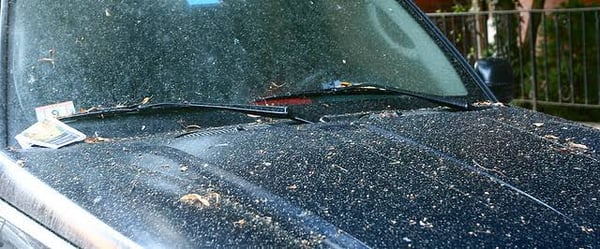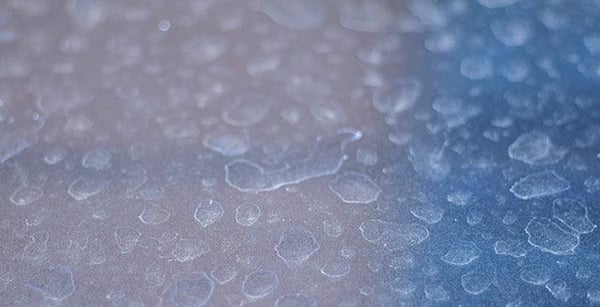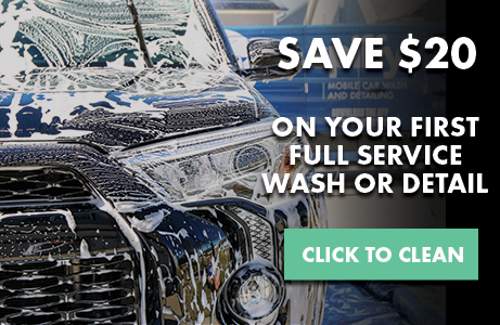As a vehicle owner, it’s essential to be aware of the countless threats that can damage your vehicle’s paint. We’ve discussed how to best protect your car's paint, but that doesn't focus too much on the common causes of damage to car paint. Not just paint scratches but additional threats to your car's exterior from unassuming sources, such as sap, bugs, or bird droppings.
Fortunately, you’ll be well-informed to prevent further damage to your clear coat from familiar yet unexpected sources with this helpful guide.

Tree Sap
One of the most common sources of car paint damage is tree sap. These small rough spots on your paint job can quickly add up whenever your vehicle is parked under a tree with a broken branch. The critical thing to know about tree sap is that it doesn’t damage your paint immediately. Instead, it gradually destroys the clear coat of your car's paintwork over time, often leaving a discolored patch or stain behind in its wake.
High temperatures, such as during the summer, speed up the process significantly by baking the sap onto your car paint. If you live in a warmer climate, it’s vital that any sap stains on your car are removed as soon as they are discovered. If not, then it will take more than a routine car detail or polishing treatment with a clay bar to keep your vehicle's paint from being significantly damaged.
If you’re looking to minimize sap's effects on your paint, consider getting your vehicle waxed regularly, such as every 1-3 months.
Bugs
If you have to drive long distances as part of your job, you likely have experience with a front bumper or grille covered in dead bugs. Not only is this a gross sight, but it’s awful for your paint as well! The acidic nature of dead bugs on your paint immediately poses a threat to your vehicle's paint and can be challenging to remove, especially when you factor in the summer heat. The longer you leave large swaths of insects on your car, the more likely your paint suffers from corrosion and leaves behind blemishes.
It’s impossible to limit your vehicle’s exposure to bug marks, but you can keep your car’s paint in mind after every drive. Being proactive with a routine car wash and front-end wipe-down with a microfiber cloth can do wonders for the long-term quality of your car's paint job.
Bird Droppings
As a car owner, it's important to expect the unexpected when it comes to your paint. That can certainly be expected when it comes to discovering bird droppings on your car. This condition can often be a gross nuisance, but it's crucial to not ignore them over time. Similar to bug splatter, these frustrating imperfects have high acidity levels, with a pH level equivalent to lemon juice.
The first step is to remove bird droppings as soon as possible to prevent long-term damage to your paint. This can easily be accomplished with a soft cloth and cleaning product or a hand wash and wax treatment if you're looking to add some extra protection for your vehicle.
Sun Damage
If you live somewhere with intense sun and heat, it's crucial to be aware of the serious damage caused to your car's surface by UV rays.
Vehicles that suffered from significant UV exposure are noticeable by the chalky oxidation on their paint, which leaves a rugged clear coat layer behind. The end result is a chemical reaction that exposes the metal underneath your car's clear coat, which can be next to impossible to correct.
The best way to avoid sun damage is to avoid leaving your car sitting out for long periods on sunny days. If you don't have a garage or shade cover, then it's crucial to provide your vehicle's paint with the protection it needs, such as routine wax or paint sealant services.

Water Spots
While water is crucial to clean your car, it can just as quickly do the opposite to your paint. Whether you have a sprinkler system for your yard or live in a more rainy part of the country, unattended water will easily cause water spots. Evaporation is the cause, as it leaves behind the trace elements from any water that sits on your paint. Most often, our technicians encounter hard water spots, which is the result of mineral-rich water that dried on the surface of your car.
The most challenging kind of water spots to remove are etched-in water spots, or “type III water spots.” These occur when the evaporation of water droplets is accelerated by heat, effectively baking the spot onto the surface of your car’s paint. If left unchecked, these water spots can leave behind permanent damage.
Vinegar has proven to be a useful hack for treating water spots at home, but the best method for avoiding them in the future is with a cleaning chemical treatment and routine wax coating.
Car ownership comes with a lot of responsibility, especially if you want your vehicle to last well into the future. While it’s easy to ignore spots on your car’s paint, it ultimately proves easier to take proactive measures and protect it. Only consistent car wash and detail services, such as waxing or a ceramic coating, can maintain the quality of your car’s paint for the long term.
If you’re looking for a professional, eco-friendly car wash and detail service that fits your schedule, then consider Spiffy as your solution. We’ll bring everything we need to make your car feel brand new, from car paint repair to washing and detailing services. Best of all, it can all be done at your home or office!
Give us a try today with $20 off your first Spiffy service. Click the image below to learn more!





